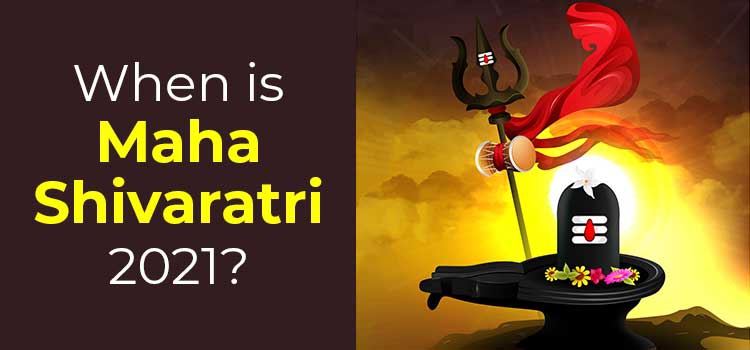When is Maha Shivaratri 2021
When is Maha Shivaratri 2021?
A festival of great significance, Maha Shivaratri is widely celebrated across India to revere Shiva, one of the most powerful Gods in Hinduism. ‘Shiv’ refers to Shiva, the Supreme Being of Shaivism, and one among the Holy Trinity of Gods, besides Brahma and Vishnu.‘Ratri’ means night.
Maha Shivaratri is an annual festival that falls in the month of Falgun (Phalguna), the last month of the Hindu calendar. Maha Shivaratri means the ‘Great Night of Shiva’ and is also celebrated as ‘Padmajarathri’. It is one of the most ancient Hindu festivals.
The 14th day of the dark fortnight of each Lunar month is especially sacred to Shiva. However, when it occurs in the month of Phalguna (Falgun) during February-March, it is a time to celebrate Maha Shivaratri, revere Shiva, and reach a higher level of spiritual devotion that can lead to Moksha (salvation).

Receive A Free Energized Rudraksha For Maha Shivaratri
Maha Shivaratri 2021 falls on Thursday, March 11th, in the Krishna Paksha (waning moon period) on Chaturdashi Thithi (date) of the Falgun month. This is according to the Hindu Panchang. Devotees observe a fast and keep an all-night vigil, during which there is a special ritual of worship performed for the deity, usually in the form of the Shiva Linga. The next day, devotees break the fast. Maha Shivaratri is not just for spiritual seekers but also for those seeking auspiciousness.
There are different aspects of when Maha Shivaratri occurred.
Ascetics may have a different perspective of the occurrence of Maha Shivaratri. According to them, it was the day when Lord Shiva became one with Mount Kailash. We must remember that in the Yogic tradition, Shiva is worshipped as the Adi Guru, the first-ever Guru (teacher) from whom emanated the science of Yoga. He was deep in meditation for millenniums. One day, he became completely still. All movement in him stopped, and the ascetics perceived Maha Shivaratri as the ‘Night of Stillness.’
According to the Hindu calendar, Maha Shivaratri occurs in the Krishna Paksha period, that of the dark lunar fortnight or waning Moon. There is an intriguing myth behind why the Moon is waxing or waning in a cycle. Moon God or Chandra Dev was married to the 27 daughters of Daksha. They were the Nakshatras (stars). However, he gave preference to Rohini, and the other sisters complained to their father, Daksha, who warned the Moon God to pay equal attention to all of them. The latter was unmindful of the warning, which angered Daksha. He bestowed a curse upon Chandra Dev that he would fade away. The wives became regretful, but the curse could not be reversed.
The terrified Moon God initially sought Brahma’s advice and then prayed to Shiva. He went to the famed Prabhasa Thirtha and made a Shiva Linga on the banks of the river Saraswati. This Shiva Linga is called the Somnath Jyotirlinga. He prayed to Shiva for six months.
Shiva appeared and offered the Moon God a boon. Chandra Dev explained his predicament. Shiva agreed that Daksha’s curse could not be reversed, but a middle path could be taken. He said the Moon God would increase in brightness (wax) during the Shukla Paksha for fifteen days. He would then wane during Krishna Paksha (dark fortnight) or on New Moon days. When this made the Moon God unhappy, Shiva then wore Chandra Dev on his coiled hair as a crescent Moon to remind his devotees they were dear to him even in their lowest moments.
There are 12 Shivaratris celebrated every year. They are called Masik Shivaratri. ‘Masik’ means monthly. Shivratri is celebrated on the fourteenth night of the dark fortnight of Krishna Paksha (during the waning Moon), which is the night before Amavasya, the New Moon day.
While Masik Shivaratri occurs every month, Maha Shivaratri falls only once a year. Shivaratri is the most important one, celebrated before spring/summer, in February or March. It also depends on the position of the planets.
Maha Shivaratri is the day when Shiva, also known as the Adi Yogi or the Adi Guru, first came into consciousness at the material level of existence. At this point, a meditator transcends space and time. It is the brightest night for the soul when the Yogi attains the state of ‘Nirvana’.
Shiva means ‘that which is not.’ He exemplifies the vast emptiness, which is all-pervading. It denotes darkness, nothingness, emptiness. Shivaratri is believed to be the darkest night of the month. Darkness has no source. Darkness is everywhere, omnipresent, like Shiva, the vast emptiness of existence.
Let Shivratri 2021 become the night of awakening, not just of wakefulness.



















